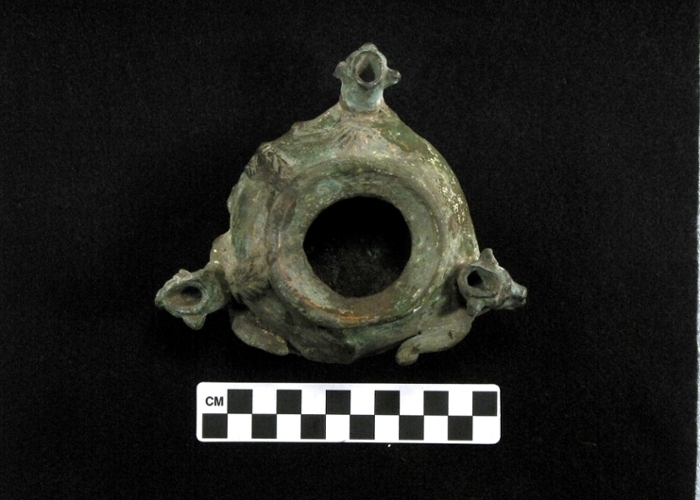Ancient Oil Lamps
-
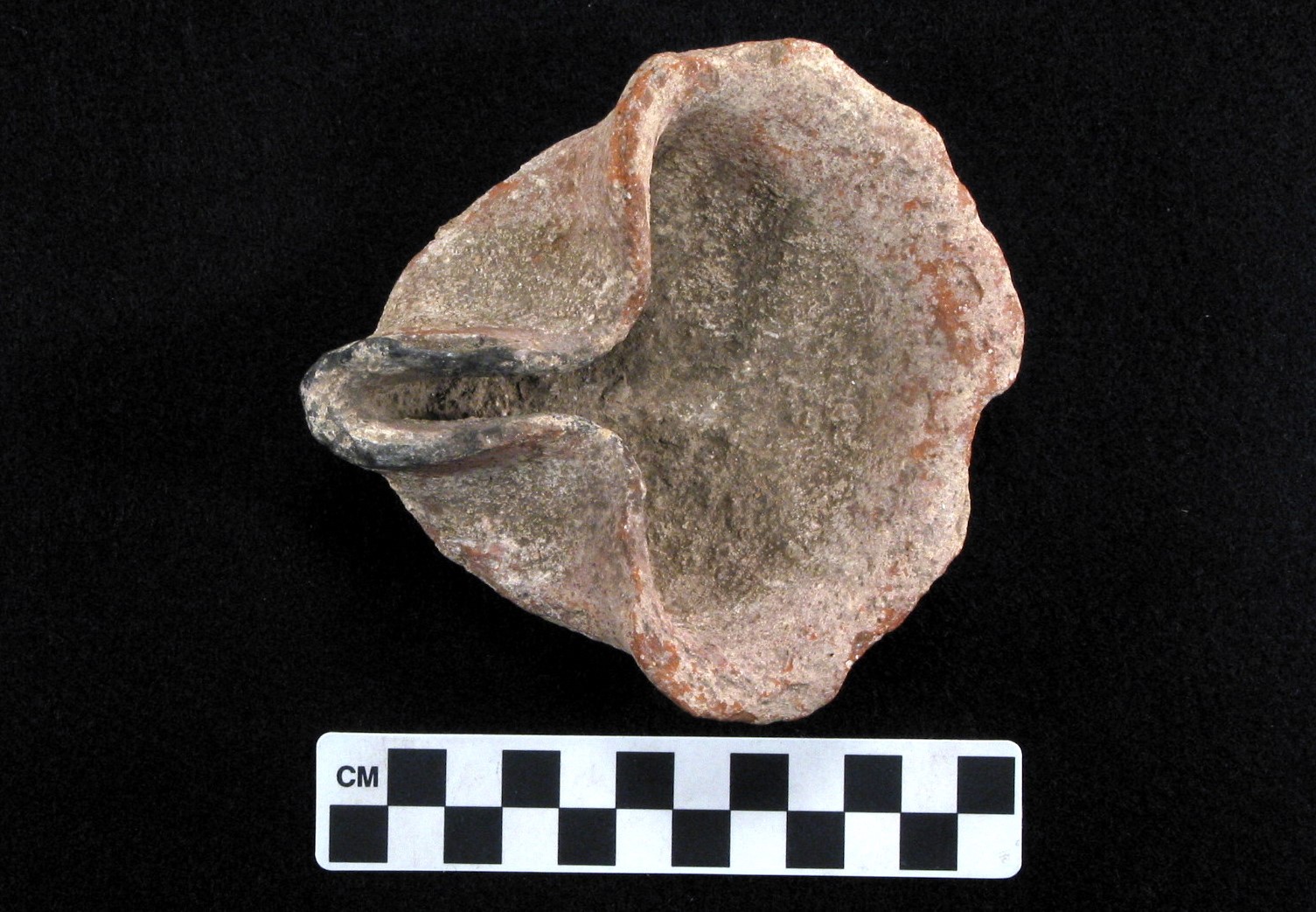
Cocked Hat Lamp
2003.30.1
Provenance unknown (eastern Mediterranean)
ca. 1500 - 600 BCE
12 cm greatest span x 5 cm high
The earliest clay lamps were shallow bowls in which a wick was floated in a pool of oil. Later versions were hand-folded to create a spout for the wick to rest in, as with this "cocked hat" lamp. The most common oil used in the Mediterranean region was olive oil. Wicks were probably made of linen, papyrus or other readily available plant fibers. -
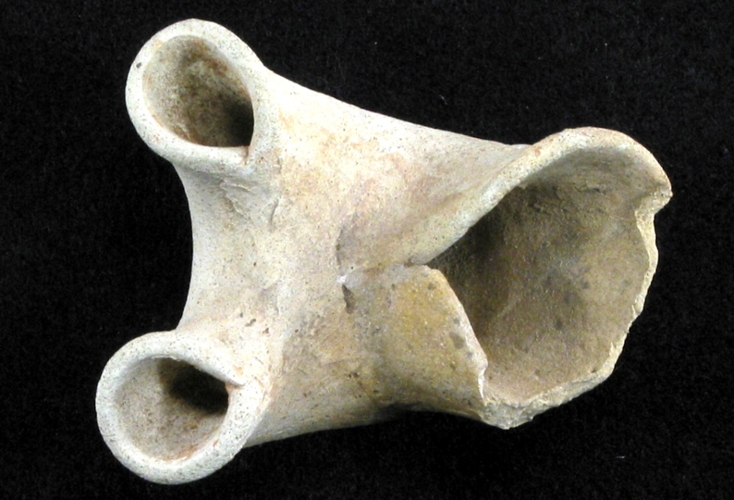
Double Nozzle Lamp with Base
1914.2345.1
Carthage, Tunisia
ca. 900 - 200 BCE
Lamp 7 cm long x 4 cm high; Base 9.7 cm diameter
Gift of Karl P. Harrington
Little is known about this lamp, but its form is a variant of the “cocked hat” lamp style. In this example, the edges of a shallow, wheel-made dish have been folded in (creating two nozzles) and pressed together, partially closing off the bowl of the lamp. The separate base may have been used for transporting the lamp when lit. -
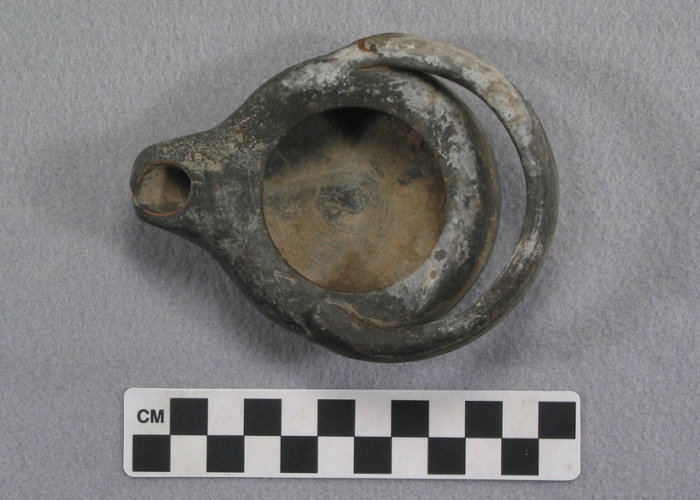
Black-Glazed Greek Lamp
1900.1774.1
Sorrento, Italy
ca. 500 - 300 BCE
11 cm long x 8.6 cm wide x 4 cm high
Gift of Mrs. W. E. Gilbert
In the 5-6th centuries BCE, Greeks began making a distinctive form of wheel-made oil lamp like the one pictured here. They had a rounded body and nozzle, a large pour hole (where the oil was added), and were often covered with a black slip glaze.
The telltale spiral marks of wheel-thrown pottery can be seen in the body's interior (enhanced detail at upper left); the nozzle and strap handle were hand-formed and attached separately. The whitish patches are mineral deposits that can accumulate on pottery buried in - or in contact with - the ground. -
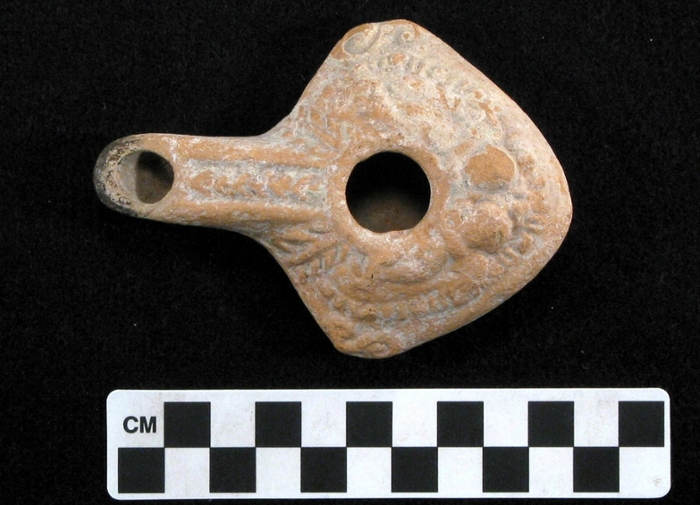
Hellenistic Lamp
1905.1947.1
Sidon, Lebanon
ca. 300 - 100 BCE
10.1 cm long x 7.1 cm wide x 2.9 cm high
The Greeks started producing mold-made lamps during the Hellenistic period, which began ca. 300 BCE. The use of molds allowed mass-production of elaborate designs. A design, such as the two winged cupids shown here (enhanced detail at right), would only need to be carved once, for the archetype. Plaster or clay molds made from the archetype could then be used to make multiple copies. -
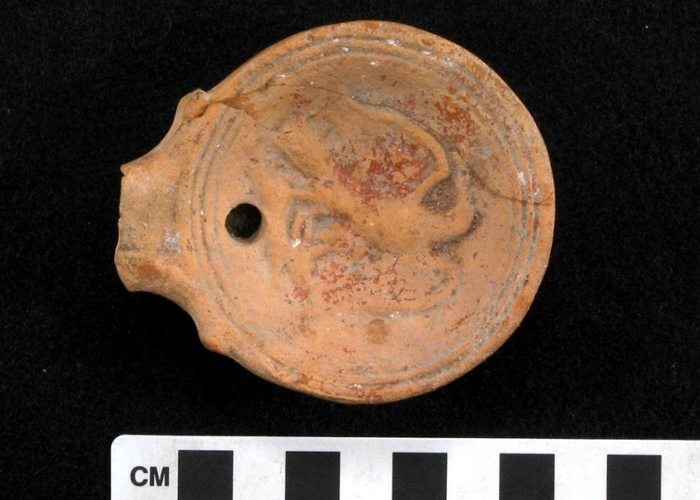
Roman Volute Nozzle Lamp
1905.1947.3
ca. 100 BCE - 150 CE
7.8 cm long x 6.9 cm wide x 2.8 cm high
By the early Roman period (1st century BCE), a distinctive mold-made lamp style had developed. "Volute nozzle" lamps are characterized by a large discus (the ornamental area on top of the lamp), small pour holes, and two ornamental volutes flanking the wick hole. Common designs included animals, mythological beings, gladiators, and erotic scenes. -
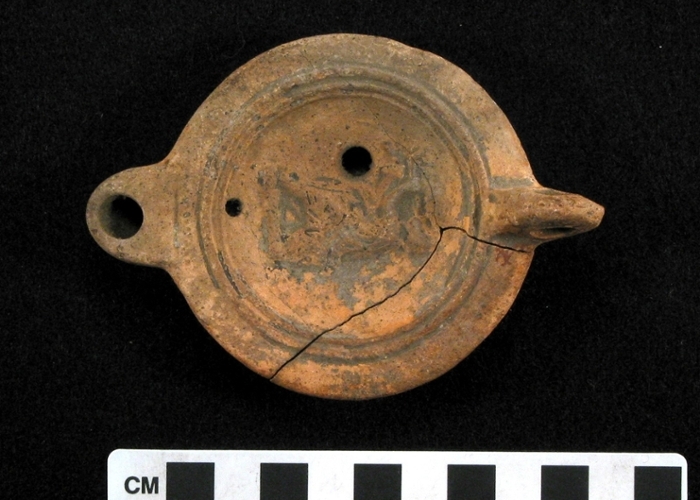
Roman Round Nozzle Lamp
2003.36.1
unknown provenance
ca. 1st - 5th century CE
10.5 cm long x 7.5 cm wide x 2.2 cm high
Another common Roman lamp style features a short, rounded nozzle and a pierced lug handle. Traces of a colored slip glaze are visible on this lamp, and is decorated with a musician playing some type of wind instrument.
The tops and bottoms of lamps were formed in separate molds that were then joined together prior to firing. -
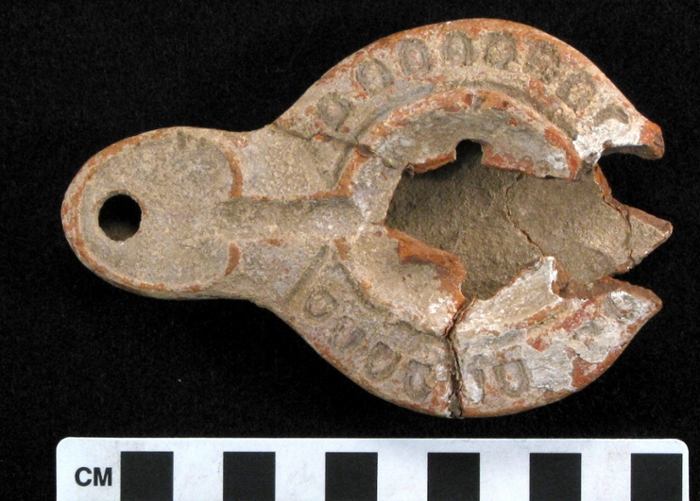
Roman Factory Lamp
1914.2340.1
Carthage, Tunisia
ca. 1st - 4th century CE
12 cm long x 7.5 cm wide x 3 cm high
Gift of Karl P. Harrington
The Roman “firmalampen” (or factory lamp) style was developed in the 1st century CE and lasted at least through the 4th century CE. Initially major factories were located in Northern Italy, but later they spread to the provinces, including North Africa. Often these lamps were stamped with the mark of the factory or maker; however, this one is anonymous. Note the channel running down the length of the nozzle, which helped divert spilled oil back into the body of the lamp. -
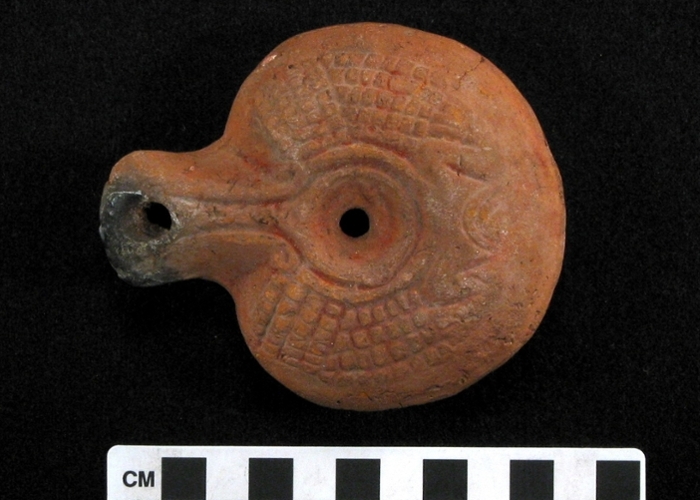
Egyptian Frog Lamp
1900.1775.1
Egypt
ca. 2nd - 5th century CE
10.5 cm long x 8.7 cm wide x 3.7 cm high
This type of lamp was produced in Egypt under the Roman Empire. It is characterized by the bulbous kidney-like shape and abstract frog design (the shape of the folded legs can be seen at top center). Frogs held a special significance in Egypt, appearing as they did after the annual flooding of the Nile, which sustained all life. Heqet, the Egyptian goddess of fertility, childbirth, and resurrection, is often depicted as a frog.
Originally, this lamp was covered in a red slip, much brighter than the natural color of the clay. Traces can be seen in crevices, especially on the base. -
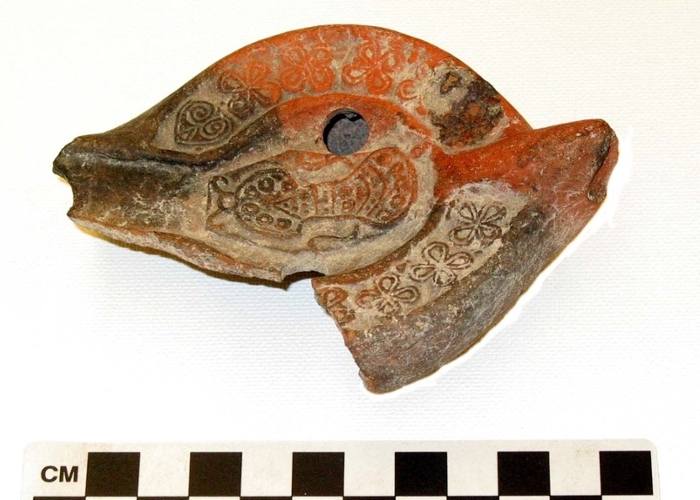
Lamp from Roman North Africa
2003.101.1
North Africa
ca. 4th - 5th century CE
11 cm long x 8 cm wide x 3.2 cm high
This lamp all represent a distinctive mold-made type produced in Roman North Africa in the 4th and 5th centuries CE. It has a sunken discus, two pour holes on either side of the central design, an unpierced lug handle, and a wide channel running down the nozzle. The central design is ringed by stylized, repetitive elements, like dolphins, scrolls, or quatrefoils. -
Hanging Lamp
2003.37.1
Provenance unknown
Style ca. 4th - 5th century CE
5.9 cm high x 11.4 cm diameter
Ancient lamps could also be made of metal, usually a copper alloy. The lamp pictured here is a 19th- or early 20th-century reconstruction of an ancient metal lamp. It appears as if someone incorporated fragments of a copper alloy original into a body of plaster and clay, then painted the piece to resemble aged bronze.
It features molded panels of draped figures on the sides and three nozzles shaped like the heads of winged lions. A lamp like this would have been suspended via chains attached to the nozzles or wings. -
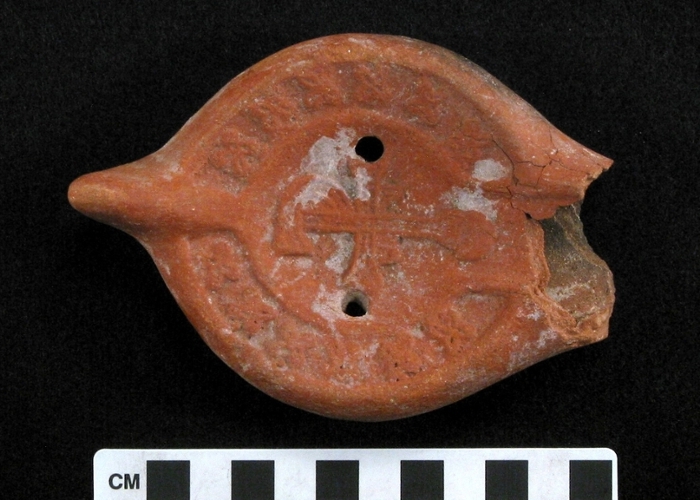
Early Christian Lamp
1914.2340.4
Carthage, Tunisia
ca. 5th - 6th century CE
13 cm long x 9 cm wide x 3.5 cm high (excluding handle)
Gift of Karl P. Harrington
This is an early Christian lamp from Roman North Africa. Note that the form is exactly the same as the other molded lamps from this region (pictured above). The only feature that marks it as Christian is the decoration. The monogram on the discus is of the superimposed Greek letters Chi “X,” and Rho “P,” the first two letters of "Christ" as it is spelled in Greek. -
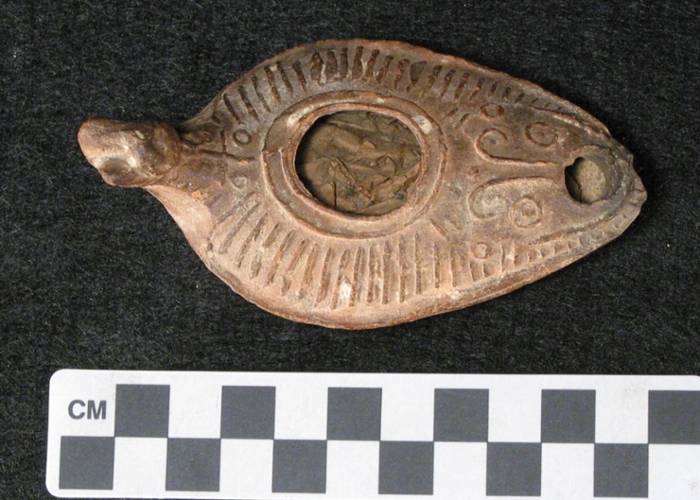
Byzantine Lamp
2003.2.3
Samaria (general region)
ca. 5th - 8th century CE
10.5. cm long x 5.5 cm wide x 4.5 cm high
Gift of Mary Dahl
In western Asia, from Byzantine into early Islamic times, lamp decoration became more abstract, featuring lines, crosses, dots, and geometric shapes. Lamps like this one have also been called "animal head" lamps, due to the appearance of the knob on the handle, or "slipper lamps," referring to the overall shape.
